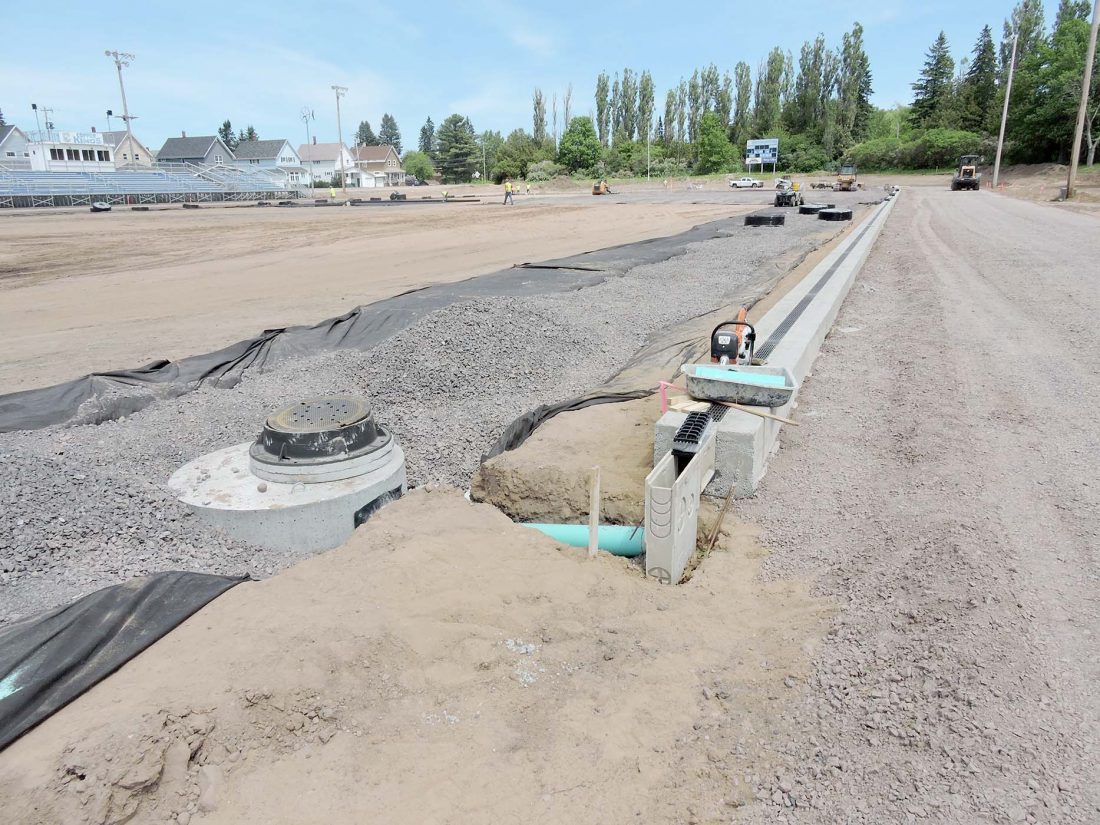UP Engineers explain Agassiz Field drainage

Graham Jaehnig/Daily Mining Gazette The under-field drainage system, as designed by Calumet High School graduate and UPA Engineer Ryan Patrick, consists of a flat, perforated pipe encased in a permeable plastic. The pipe is laid atop a geotextile layer, which is then covered with a layer of washed gravel.
CALUMET — Ryan Patrick, engineer with UP Architects and Engineers (UPA) designed the storm water system that will lay beneath Agassiz Field, which will eliminate rainwater and snow melt that previously collected on the site, severely limiting access and usage of the field and the track surrounding it.
“The majority of it consists of 24-inch, perforated pipe wrapped in a stone envelope, so that a lot of the water will infiltrate into the ground,” Patrick said, “and if it cannot do that, it will store and eventually — if the stone is big enough — meter out into the storm sewer system located at the southeast section of the field, on Elm Street, which is a six-inch outlet, so it will taper down.”
The stone is a washed gravel, from which sand and silt has been removed so that water can seep through it easily.
Lining the trench beneath the gravel is also a layer of geotextile fabric that will further improve water filtration.
“One of the challenges we had was because the site was taking all that water,” Patrick said, “you can’t just take all that water and put it all into an existing storm water system, because chances are, it’s already undersized and can’t handle that (volume). So, we had to design a system to either store (water) or infiltrate it into the ground, because we’re only allowed to meter out so much at a time. Whatever currently went into that system, that’s all we were allowed to put into that system. The rest of it we had to have space for water storage, so it can slowly infiltrate into the ground.”
“In simple terms,” said Project Manager Tim Purdy, “this project has solved a water problem in that end of town. There are 13 drainage basins collecting water that were coming from a lot of places.”
“All of that 24-inch pipe is installed flat,”said Patrick, “so it’s going to fill at the same rate, but it will also perk out at the same rate, too. It’s designed for a 100-year storm event, but if you get something above that, like we had last year, it will take that up to that six-inch pipe, and will help contain that.”
The entire complex will appear as dry, with the water being stored underground, Purdy explained. If the underground storage should reach capacity to a point where the water is ready to bubble up to the surface, it will be carried to an exit pipe, which will carry it into a village’s storm sewer system at a point on Elm Street.
“So, the sewer that used to take the water doesn’t see hardly any anymore,” said Purdy, “We’re storing it all here (under the field),keeping it all here, and seeping it back into the ground, and what overage there may be dumped into the village sewer system.”
Superintendent Chris Davidson said that he anticipates the new system will add weeks to the district’s track schedule. The drainage system, along with the artificial turf, will allow for football practice every day.
Previously, he said, with snow melt, then additional rain, there was a period of at least two weeks before the field dried up again.


